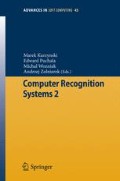Abstract
In this paper, it is shown that active hypercontours can be interpreted as a method for information fusion. The fusion concerns using of information from diverse sources and of different type (data and knowledge). Moreover, active hypercontours can work as group classifiers.
Access this chapter
Tax calculation will be finalised at checkout
Purchases are for personal use only
Preview
Unable to display preview. Download preview PDF.
References
Ho T.K., Hull J.J., Srihari S.N. (1994): Decision Combination in Multiple Classifier Systems. IEEE Trans, on Pattern Analysis and Machine Learning, vol. 41, pp. 723–744.
Bauer E., Kohavi R. (1999): An Empirical Comparison of Voting Classification Algorithm: Bagging, Boosting and Variants. Machine Learning, vol. 36, pp. 105–142.
Ji C., Ma S. (1997): Combination of Weak Classifiers. IEEE Trans. on Pattern Analysis and Machine Learning, vol. 8, pp. 32–42.
Kittler J., Hatef M., Duin R.P.W., Matas J. (1998): On Combining Classifiers. IEEE Trans, on Pattern Analysis and Machine Learning, vol. 20, pp. 226–239.
Kuncheva L.I., Jain L.C. (2000): Designing Classifier fusion Systems by Genetic Algorithms. IEEE Trans. on Evolutionary Computation, vol. 4, pp. 327–336.
Kuncheva L.I., Jain L.C. (2002): Switching between Selection and Fusion in Combining Classifiers: An Experiment. IEEE Trans. on Systems, Man and Cybernetics, Part B: Cybernetics, vol. 32, pp. 156–150.
Kuncheva L.I., Whitaker C.J., Shipp CA., Duin R.P.W. (2003): Limits on the MajorityVote Accuracy in Classifier Fusion. Pattern Analysis and Applications, vol. 6, pp. 22–31.
Kuncheva L.I. (2004): Combining Pattern Classifiers: Methods and Algorithms. Wiley-Interscience, New Jersey.
Kurzyski M., Woniak M. (2000): Rule-based Algorithms with Learning for Sequential Recognition Problem. Proc. of the Third Int. Conference on Information Fusion-Fusion’ 2000, Paris, France, TuC5: 24–29.
Kurzyski M. (2004): Consistency Conditions of Expert Rule Set in the Probabilistic Pattern Recognition. Lecture Notes in Computer Science, LNCS-3314, pp. 831–836.
Kurzyski M. (2005): Combining Rule-based and Sample-based Classifiers Probabilistic Approach. Lecture Notes in Computer Science, LNCS-3704, pp. 298–307.
Lam L. (2000): Classifier Combinations: Implementations and Theoretical Issue. Lecture Notes in Computer Science, LNCS-1857, pp. 77–87.
Woniak M. (2006): Metody fuzji informacji dla komputerowych systemw rozpoznawania (Methods for information fusion for computer recognition systems); in Polish. Oficyna Wydawnicza Politechniki Wrocawskiej, Wrocaw.
Grzeszczuk R., Levin D. (1997): Brownian Strings: Segmenting Images with Stochastically Deformable Models. IEEE Trans. on Pattern Analysis and Machine Intelligence, 19, no. 10, 100–1013.
Kass M., Witkin W., Terzopoulos S. (1988): Snakes: Active Contour Models. Int. Journal of Computer Vision, vol. 1, no 4, 321–333.
Caselles V. Kimmel R., Sapiro G. (2000): Geodesic Active Contours. Int. Journal of Computer Vision, 22(1), 61–79.
Tomczyk A. (2005): Active Hypercontours and Contextual Classification. Proceedings of the 5th International Conference on Intelligent Systems Design and Applications-ISDA’2005. Wroclaw, Poland, IEEE Computer Society Press, pp. 256–261.
Tomczyk A., Szczepaniak P.S. (2005): On the Relationship between Active Contours and Contextual Classification. In: M Kurzyski, et al. (Eds.): Computer Recognition Systems. Proceedings of the 4th Int. Conference on Computer Recognition Systems-CORES’05. Springer, Berlin, Heidelberg, New York, pp. 303–310.
Tomczyk A., Szczepaniak P.S. (2006): Adaptive Potential Active Hypercntours. Proceedings of the 8th International Conference on Artificial Intelligence and Soft Computing ICAISC’2006. Zakopane, Poland. Springer-Verlag, Berlin, Heidelberg; pp. 692–701.
Pedrycz W., Loia V. (2004): P-FCM: A proximity-based fuzzy clustering. Fuzzy Sets and Systems, vol. 128, pp. 21–41.
Tomczyk A. (2007): Image Segmentation using Adaptive Potential Active Contours. In: Computer Recognition Systems. hProceedings of the 5th Int. Conference on Computer Recognition Systems-CORES’07 (this volume).
Author information
Authors and Affiliations
Editor information
Editors and Affiliations
Rights and permissions
Copyright information
© 2007 Springer-Verlag Berlin Heidelberg
About this paper
Cite this paper
Szczepaniak, P.S. (2007). Active Hypercontour as Information Fusion Method. In: Kurzynski, M., Puchala, E., Wozniak, M., Zolnierek, A. (eds) Computer Recognition Systems 2. Advances in Soft Computing, vol 45. Springer, Berlin, Heidelberg. https://doi.org/10.1007/978-3-540-75175-5_41
Download citation
DOI: https://doi.org/10.1007/978-3-540-75175-5_41
Publisher Name: Springer, Berlin, Heidelberg
Print ISBN: 978-3-540-75174-8
Online ISBN: 978-3-540-75175-5
eBook Packages: EngineeringEngineering (R0)

